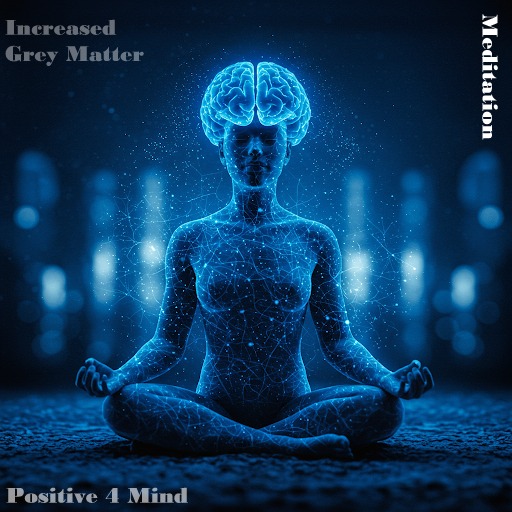Understanding Gray Matter
-
What Is Gray Matter?:
- Gray matter refers to regions of the brain made up primarily of neuronal cell bodies, which process information in the brain.
- It forms the outer layer of the brain (cerebral cortex) and clusters deep within the brain, playing crucial roles in muscle control, sensory perception, memory, emotions, speech, decision making, and self-control.
- Think of gray matter as the brain's "processing centers," similar to the CPU in a computer.
-
The Importance of Brain Volume:
- Higher gray matter volume in specific regions correlates with enhanced cognitive abilities related to those areas.
- Neuroplasticity – the brain's ability to reorganize itself by forming new neural connections – allows these regions to grow or shrink based on use and stimulation.
- While the brain naturally loses some volume as we age, practices like meditation can counteract this decline and even reverse it in certain areas.
-
How Meditation Changes the Brain:
- Meditation creates a unique state of focused attention and awareness that stimulates specific neural pathways, strengthening them over time.
- This repeated activation leads to increased dendritic branching, synaptogenesis (formation of new synapses), and even neurogenesis (creation of new neurons) in certain regions.
- These physical changes manifest as measurable increases in gray matter volume that can be detected through MRI scans.
Key Brain Regions Enhanced by Meditation
-
Prefrontal Cortex:
Located in the frontal lobes, this region governs executive functions including attention, planning, and emotional regulation. A landmark study at Harvard found that just 8 weeks of meditation led to significant increases in gray matter in the prefrontal cortex, enhancing focus and emotional control.
-
Hippocampus:
This seahorse-shaped structure plays a crucial role in learning and memory formation. Research published in NeuroImage showed that regular meditators had larger hippocampal volumes compared to non-meditators, suggesting improved memory capacity and learning ability.
-
Insula:
The insula processes bodily awareness and interoception (the sense of the body's internal state). Studies show meditation increases gray matter in this region, improving our ability to recognize internal signals like emotions, hunger, and discomfort – a key aspect of emotional intelligence.
-
Posterior Cingulate Cortex:
This region is involved in self-reference and mind-wandering. Meditation strengthens this area, improving our ability to maintain present-moment awareness instead of getting lost in rumination about the past or future.
-
Temporoparietal Junction:
This brain region is associated with empathy and compassion. Research shows that compassion-based meditation practices particularly increase gray matter in this area, enhancing our capacity for understanding others' emotions and perspectives.
The Research Evidence
-
Harvard's Groundbreaking Study:
Researchers at Massachusetts General Hospital conducted a landmark study where participants practiced mindfulness meditation for just 30 minutes daily over 8 weeks. MRI scans showed measurable increases in gray matter concentration in the hippocampus, posterior cingulate cortex, temporo-parietal junction, and cerebellum – all critical regions for learning, memory, emotional regulation, and perspective-taking.
-
UCLA's Research on Aging Brains:
A study from UCLA found that long-term meditators had better-preserved gray matter with age compared to non-meditators. While most people lose brain volume as they age, meditation practitioners showed significantly less age-related gray matter loss across multiple brain regions.
-
Yale University Findings:
Researchers at Yale discovered that meditation decreases activity in the default mode network (DMN) – the brain network responsible for mind-wandering and self-referential thoughts. This decreased activity corresponded with increased gray matter in attention and sensory processing regions.
-
Johns Hopkins Meta-Analysis:
A comprehensive review of 47 studies found that meditation programs consistently led to changes in brain structure and function, with measurable improvements in attention, depression, anxiety, pain, and stress.
Benefits and Implications
- Enhanced Cognitive Function: Increased gray matter in attention networks translates to improved focus, concentration, and information processing.
- Emotional Resilience: Growth in regions responsible for emotional regulation means better stress management, reduced anxiety, and greater emotional stability.
- Memory Enhancement: Hippocampal growth supports better memory formation and retrieval, potentially offsetting age-related memory decline.
- Empathy and Compassion: Increased volume in social cognition areas enhances our ability to understand and connect with others.
- Neurological Protection: Evidence suggests meditation's brain-enhancing effects may protect against neurodegenerative conditions and age-related cognitive decline.
- Pain Management: Changes in brain regions that process pain sensations can lead to improved pain tolerance and reduced suffering.
Effective Practices for Brain Growth
-
Focused Attention Meditation:
This practice involves concentrating on a single object, such as the breath, a mantra, or a candle flame. Research shows it particularly enhances the anterior cingulate cortex, which governs attention and executive function.
-
Open Monitoring Meditation:
This involves non-judgmental awareness of whatever arises in your experience. Studies indicate it strengthens the insula and sensory cortices, improving emotional recognition and body awareness.
-
Loving-Kindness Meditation:
This practice focuses on developing compassion for oneself and others. Research shows it specifically increases gray matter in areas associated with empathy and emotional processing.
-
Body Scan Meditation:
Systematically bringing attention to different parts of your body enhances the insula and somatosensory cortex, improving interoception and body awareness.
Establishing Your Brain-Enhancing Meditation Practice
- Start Small: Begin with just 10 minutes daily. The Harvard study mentioned earlier showed brain changes with just 30 minutes of daily practice over 8 weeks.
- Consistency is Key: Regular, shorter sessions are more effective for brain growth than occasional longer ones.
- Mix Techniques: Different meditation styles affect different brain regions, so varying your practice can maximize brain-wide benefits.
- Be Patient: Visible changes in brain structure typically emerge after 8 weeks of consistent practice, though some cognitive benefits may be noticeable sooner.
- Create Triggers: Link your meditation practice to existing habits to ensure consistency, which is crucial for brain growth.
Conclusion
The discovery that meditation actually increases gray matter represents one of the most profound intersections of ancient wisdom and modern neuroscience. It demonstrates that our brains are not fixed entities but remarkably adaptable organs that physically respond to our mental activities.
By dedicating just a few minutes each day to meditation, you're not merely calming your thoughts – you're literally growing and strengthening the physical structure of your brain. This process enhances everything from your cognitive abilities to your emotional resilience, potentially offering protection against age-related decline.
The power to reshape your brain lies within your own mind. The practice is simple, requires no special equipment, and can be done anywhere. The benefits, backed by rigorous scientific research, extend far beyond momentary calm, influencing the very structure of your brain in ways that enhance your life in profound and lasting ways.

